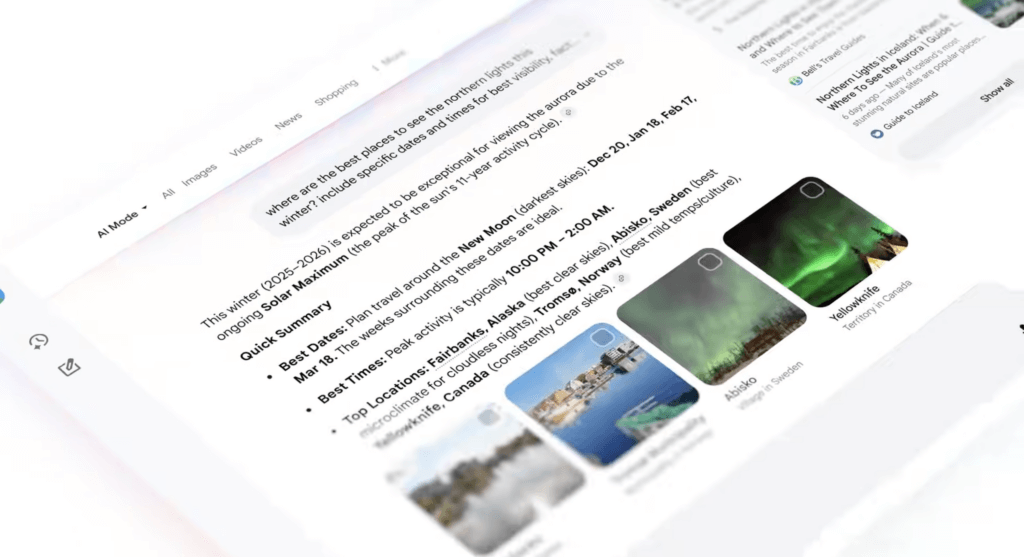The age of AI search isn’t a distant future – it’s here, today, changing the search marketing game right before our eyes. Gartner predicts that by 2026, traditional search traffic will drop by 25% as consumers increasingly turn to AI tools like ChatGPT, Perplexity, and Gemini to get answers. Worse yet, Ahrefs has seen a correlation with a 34.5% lower average clickthrough rate (CTR) for top-ranking pages with an AI Overview. But all hope is not lost.
“In fact, if you put content and links within AI Overviews, they get higher clickthrough rates than if you put it outside of AI Overviews.” – The Verge: Sundar Pichai, CEO, Google.
Welcome to the era of AI Optimization (AIO), where visibility is no longer just about ranking on Google, but about being findable and reference-able in the places AI tools pull their information from. So what are leading marketers doing about it?
We asked them. Here’s what a few brands had to say:
1. Moving Fast, But With Guardrails
As a global fintech brand, Paysafe faces an added layer of complexity: compliance. But that hasn’t stopped CMO Alisa Barber from deploying AI across her marketing stack:
“At Paysafe, we’re embracing AI as a powerful driver of both creativity and efficiency… AI is helping us test and refine messaging faster, target with greater precision, and deliver value to our audiences in more dynamic ways.”
Still, Barber is careful to balance innovation with brand consistency:
“In high-trust verticals like payments and sports betting, you can’t afford to move fast and break things. At Paysafe, we’re focused on moving fast with intention—making sure AI enhances the customer experience without compromising trust, compliance, or creativity.”
2. Authenticity Meets Accessibility
For Jimmy Zollo, co-founder of caregiving apparel brand Joe & Bella, the AI era is all about staying connected to real customer needs—while adjusting content formats to stay visible.
“We’ve integrated a chatbot into our website to help answer common questions from customers. This isn’t just about automating responses; it’s also to help keep our brand accessible and ready to address customer needs in real time.”
Zollo’s team is also investing in multichannel storytelling, knowing that AI tools often scrape content from a variety of sources:
“We’re focused on preserving a warm, authentic message… That said, we’re also crafting compelling content that provides valuable education around adaptive clothing—a lot of this content is picked up by AI platforms like ChatGPT.”
3. Doubling Down on Local Search
For Jeremy Yamaguchi, CEO, Cabana – AI search has reinforced the importance of local SEO:
“AI-driven search inevitably makes it more difficult to promote your website… Optimizing local search helps us lean into our niche expertise and offerings while reaching the exact people that are most relevant.”
Rather than compete for broad search visibility, Cabana focuses on showing up for high-intent, location-based queries—ensuring AI assistants and chatbots have clear, geo-specific content to reference.
4. Zero-Click is Still a Win
For Abdullah Sharief, CMO of Panda Hub, the biggest mindset shift has been moving beyond traditional keyword ranking:
“We’re starting to treat zero-click visibility as a win. If someone sees our expertise quoted or referenced inside an AI response, that’s a brand impression.”
Panda Hub is now optimizing content for referenceability—not just readability. That includes modular content formats, internal linking, and building authority through consistent tone and structure.
“Marketing now is less about matching a phrase and more about whether our brand and content make sense in a broader knowledge map.”
5. From Search Results to Contextual Interactions
Kyle Sobko, CEO of SonderCare, sees AI as a way to connect more meaningfully—rather than just rank higher.
“We are redirecting our content creation to use natural language and conversational keywords, knowing that AI-based tools… will seek connections in context-based customer answers.”
His team has also implemented AI-based support tools and data-driven personalization:
“We are enhancing data collection and analysis efforts to develop more customized campaigns—we predict this change will establish a 20% growth in conversions this year.”
But Sobko is also watching the broader shift carefully:
“The challenge we see will be how we maintain brand visibility over time in a world where relevancy rules in a search results environment increasingly skew toward AI-curation.”
7. Writing for AI’s Thought Process
For Shaun Carse, Director at Trackershop, adapting to AI search means fundamentally rethinking the brand’s content strategy:
“We stopped writing for Google spiders and now we’re writing for AI’s thought process.”
That means simplifying, clarifying, and writing like a helpful human—not a marketer. Trackershop has also become laser-focused on AI mentions, not just rankings:
“It’s not ranking #1 on Google that matters these days—it’s getting mentioned by AI assistants.”
To ensure Trackershop stays surfaced, Carse’s team has built a “Wikipedia strategy”—creating deep, educational content that AI tools can easily parse and cite.
The Bottom Line: AIO Is No Longer Optional
Across all of these examples, one theme is clear: AI Optimization is no longer an experiment—it’s a strategic imperative. The brands that will win the AI era won’t just be technically proficient—they’ll be context-aware, story-driven, and relentlessly useful.
Whether it’s rewriting for AI readability, expanding into zero-click formats, or doubling down on local and entity-based content, the playbook is evolving fast.
And as Carse puts it best:
“It’s not about following the algorithm to us—it’s being present helpfully, frequently, and authentically wherever humans (now including algorithms too) are looking for information.”
Your Brand’s Reputation Starts in AI Search
We’ve analyzed 60 fintech payment brands to uncover who leads in AI visibility across ChatGPT, Perplexity, and Gemini, and why most are falling behind.






